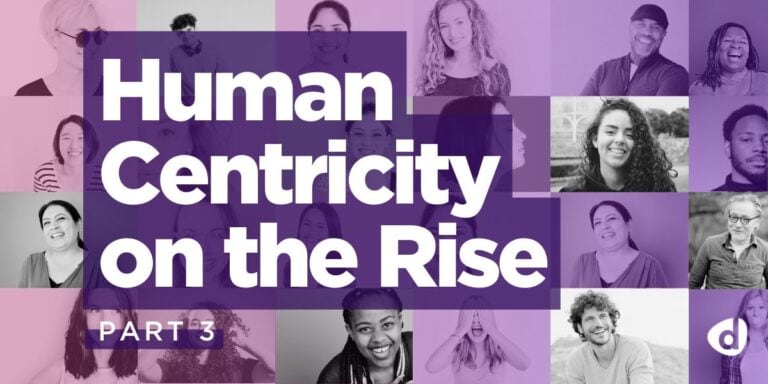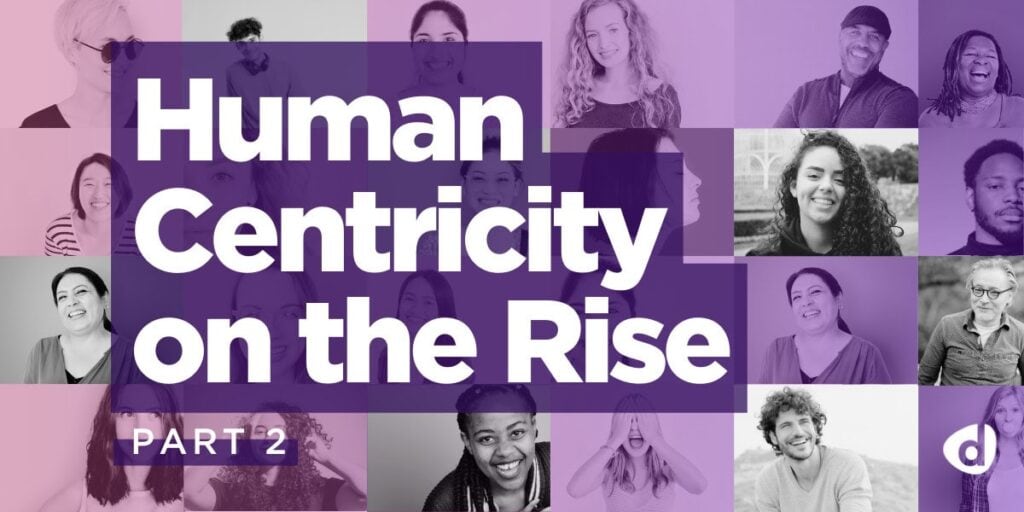Human Centricity on the Rise: Navigating the New Era, Part 3

How to unlock human centricity at scale with a key mindset shift
In Part 1 of this blog series, I highlighted the key insights from the 2024 GRIT Insights Practice Report. In Part 2, I shared perspectives from some of our industry conversations with insights leaders from PepsiCo, Edgewell Personal Care, and Reckitt. Now, in this final installment, I’ll dive into the opportunities in this new era of qualitative research and the critical mindset shift needed to seize them.
The current approach isn’t working.
It’s too slow.
Simply put, there’s too much time involved at every step – from finding participants to scheduling interviews, to collecting the feedback, and especially the manual analysis where you’re spending weeks or even months combing through hundreds of hours of interviews and pages of transcripts.
We know that being slow means you’re already behind. The longer it takes to gather and analyze these insights, the more disconnected you become from what consumers actually want. This delay leaves you vulnerable to missing crucial market trends, losing relevance, and ultimately hurting your bottom line. In this new era, where consumers are evolving and changing faster than ever before, businesses need a quick and easy lifeline to their consumers.
It’s too complex.
Beyond the time drain, the process itself is often unnecessarily complex. When you’re juggling respondents in a spreadsheet, using one tool for focus groups, another for diaries, and storing your videos in Google Drive or One Drive, you’re dealing with too many moving parts.
This fragmented approach makes the insights less accessible across your teams because they’re scattered across disparate locations, tools, and platforms. Collaboration becomes nearly impossible, and the valuable insights you gather often get trapped in silos, limited to the knowledge of the team member who conducted the interview.
To make matters worse, dealing with purchase orders (POs) and statements of work (SOWs) for every project adds layers of hassle, making the entire process feel like more trouble than it’s worth.
It’s too expensive.
Then there’s the cost. Even if you’re not flying people across the country for in-person interviews, when you’re paying per project or per session, costs pile up fast.
Worse, this complexity and cost often make teams think twice about conducting more research, because they’re worried about it eating into their budgets. And that’s exactly what you don’t want—fewer conversations with consumers, fewer insights, and fewer opportunities to stay ahead of shifting market trends.
It’s too hard.
The hurdles of time, cost, and complexity lead to one conclusion: qualitative research feels too hard to do frequently or effectively. When teams aren’t comfortable with the process and don’t have a quick, cost-effective, and easy way to run research, qual falls by the wayside.
All of these big strategic goals of being consumer-centric don’t materialize because teams are defaulting to rely on transactional data—CRM stats, POS figures, or quantitative data—that doesn’t tell them the all-important “why.”
It’s time to make a change.
So, how do we shift our mindset and embrace a new approach that actually encourages more frequent consumer conversations? How do we make it easy to glean insights in real-time and break down the barriers of the old way of doing things?
The key lies in adopting a mindset that isn’t just about working faster—it’s about working smarter. It’s about moving away from fragmented, cumbersome processes and embracing technologies and solutions that integrate everything in one place, that simplify the research process, and make consumer conversations a seamless and regular part of how we operate.
In the next section, I’ll explore how modern qualitative research tools and strategies can help you overcome these challenges, making it easier to stay connected with your consumers and drive more informed business decisions.
The opportunity to truly unlock human centricity.
From costly conversations to incentivizing consumer closeness.
Shift from viewing customer interactions as an expense to seeing them as a valuable investment in your business. You have to recognize, if you don’t already, that engaging in frequent customer interactions can lead to significant business benefits. A study of over 1,300 organizations across 80 countries found that 84% of organizations focusing on improving customer experiences saw increased revenue, and 79% reported significant cost savings.
Consider adopting a solution with an unlimited usage model, where you pay one price for all your research needs including unlimited access to the technology, services (project management, live tech support, etc.), on-demand training and a dedicated support team to set you up for success. With this approach, you can conduct as much research as you want without worrying about the price per interview or price per project, so your teams will be encouraged to engage with consumers more.
From lengthy analysis times to instant human-centric insights with GenAI.
You have to accept that with the pace of the market and the pace of consumer evolution, your teams simply don’t have time to manually sift through and analyze this unstructured, qualitative data. You can replace the weeks or months spent on this manual analysis and enable your teams to have clarity and insights from consumer feedback instantaneously with GenAI.
With so much innovation in the space of GenAI, it’s now easier than ever to uncover key insights from your conversations with consumers, whether they took place in a live interview or focus group, an asynchronous study, or even if you want to analyze recordings from some of your previous research. Researchers can now interact with their data and leverage GenAI to get answers to their specific research questions that are validated with summaries and quotes directly from the interviews.
If you want to learn more about the key ways you can use GenAI in qual today as well as future opportunities and applications for the technology, I invite you to check out this quick guide.
From complexity at every step to the easy button for qual.
You shouldn’t have to create a PO every time someone on your team or at your organization wants to talk to a consumer. It shouldn’t be complex, cumbersome, or hard to do qual.
You need an easy button on both the technology side as well as the services so that anyone across your organization, regardless of their role or experience, can easily run research projects – from brand and marketing teams to product and R&D. Imagine if one of your marketers could simply say, “Hey, I want to get our customers’ opinions on this,” and by the end of the day, they’re able to launch the research project all on their own.
From disparate systems and siloed insights to one global ‘human centricity’ hub.
You need a centralized hub for global human-centric insights—an “always-on” platform that’s accessible 24/7, allowing your team members anywhere in the world to tap into critical consumer feedback to uncover key themes, answer business questions, and inform strategies. Your teams need the ability to understand the thoughts, opinions, and behaviors of their consumers and influencers, anytime and anywhere.
If you’re still using multiple platforms for qual, it’s time to streamline into one solution that not only supports any research objective – from concept development to consumer closeness – but that houses all of the tools you need to run your research in one place, from launching a project to collecting feedback to analyzing the insights.
In this recent industry article, I speak about how tech consolidation is shaping the way modern businesses operate today.
Discuss: Changing the game in this new era
At Discuss, we understand that in qualitative research, it’s not just about having the right technology, but also ensuring that the tech is easy for everyone to use and integrates seamlessly into the research process. That’s why we offer a way for global organizations to have unlimited access to both the technology as well as the services that are needed to run all of their qual projects.
Whether you’re conducting live in-depth interviews, focus groups, asynchronous studies, or analyzing recordings from past research, we make it simple. Our intuitive platform and cutting-edge GenAI tools are eliminating the complex, time-consuming, expensive nature involved in qualitative research, helping you to scale human centricity across your organization.
If you’re tired of qual being too slow, too complex, too expensive, and too hard, talk to one of our experts to discover how to transform your approach.
About Jim Longo:
Jim Longo is the Co-Founder and Chief Strategy Officer at Discuss, a purpose-built qualitative research platform for insights teams. He brings 35 years of domain expertise in the market research industry. Jim has consulted with brands and research agencies around the world on how to have insightful online conversations. Jim is considered a thought leader with regards to online behavior and market research technology. Connect with Jim on LinkedIn.
Ready to unlock human-centric market insights?
Related Articles

Why Your Business Needs a Multicultural Marketing Strategy
A recent Ad Age article highlights a notable trend that some companies are taking a stand to keep DEI at…
A recent Ad Age article highlights a notable trend that some companies are taking a stand to keep DEI at…

Empathy & Human Centricity Design | Discuss
By Adam Mertz, Chief Growth Officer at Discuss Introduction I recently had the opportunity to moderate a compelling discussion between…
By Adam Mertz, Chief Growth Officer at Discuss Introduction I recently had the opportunity to moderate a compelling discussion between…

Human Centricity on the Rise: Navigating the New Era, Part 2
Explore the strategies driving success as global leaders prioritize human centricity in future-proofing consumer insights In the first blog of…
Explore the strategies driving success as global leaders prioritize human centricity in future-proofing consumer insights In the first blog of…
